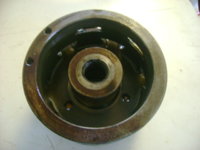As GGGary stated, you allready said you took the reading's of the white wires, and then to the cover. I only mentioned the 115 volt test for use only on a questionable stator. I think you said you thought your stator is not shorted to the case. On Bikernet .com, you could look at the schematic for the charging system and go from there. The resistance on the three white's should be at .1-.5, and the rotor should be 5.5-6.0. The reason for the schematic is to check ALL your connector's physically, not just eyeball. Take them out of the holder's and look where they are crimped to the wire. This is a common area for problem's. And, like Gary said, the wiring where it goe's by the chain get's very brittle and intermitent problem's could be right there. I remember your saying that there is minimal electric's, and I am pressumeing your using just the stock wiring for the charging system. The rectifier/regulator has to be grounded, real good, as this is what regulates the system. It could be that the battery is too small for this system, and caused the rgulator to now test good, but give false signals. I had one that did just that, would charge, then be stuck at the side of the road. Thats when I got one of those Kuriyakin LED voltmeter's. It showed me that it would be charging, then, for no reason, start going crazy, up, down, flat, overcharge, ect. I was lucky to have a couple of regulator assy., and put in another, and all was good after that. I think my regulator went bad because of a bad engine ground. Burned up 3 rotor's, and I think thats what did it.


